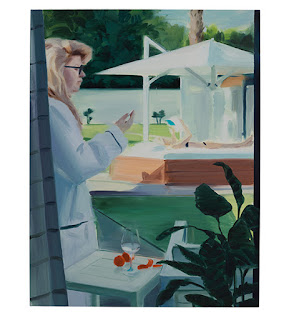It is not easy to find inspiration to write a post for a blog.
If you spend your time traveling, cooking, designing or maybe wandering without a job except your own blog, maybe is easy. But not when you are outside, just working and with two days to do what you want.
I'm not gonna complain.
Caroline Walker appears in an art magazine that I read, because of a recent publication about Hockney's pool. The Scottish painter is one of the artists that takes Hockney's pool as a subject too, and extends up. But Hockney uses male figures, and that woman prefers other women for her paintings. Her style is described as glamorous and sinister, because the viewer become an intruder like in Hitchcock film's The rear window. We are someone looking something that we shouldn't. But also she is criticized for the rich lifestyle that she depicts. Of course, her work is a consequence of David Hockney's pools, because she just works with actresses and models like Hockney with friends and relatives with nice houses and money.
As she says, she only is interested in women figures inside domestic spaces, but she adds something unusual, and occasionally sinister, is afoot – the product of a pervading sense of film-like drama that leaves you wondering who exactly these women are and whether things are in fact as perfect as they seem.
She creates scenes open up, turn around and delve behind the surfaces of mirrors. With their vertiginous angles and strategically-placed, suggestive props (rubber gloves, hair clips, plastic bags, oranges), Walker's paintings are indebted to both Hitchcock’s Vertigo (1958) and the recent film Chloe (2009), which opens with the female protagonist looking at herself in a mirror. All of these are the characteristics of her work, and you decide if you want to continue watching.
If you spend your time traveling, cooking, designing or maybe wandering without a job except your own blog, maybe is easy. But not when you are outside, just working and with two days to do what you want.
I'm not gonna complain.
Caroline Walker appears in an art magazine that I read, because of a recent publication about Hockney's pool. The Scottish painter is one of the artists that takes Hockney's pool as a subject too, and extends up. But Hockney uses male figures, and that woman prefers other women for her paintings. Her style is described as glamorous and sinister, because the viewer become an intruder like in Hitchcock film's The rear window. We are someone looking something that we shouldn't. But also she is criticized for the rich lifestyle that she depicts. Of course, her work is a consequence of David Hockney's pools, because she just works with actresses and models like Hockney with friends and relatives with nice houses and money.
As she says, she only is interested in women figures inside domestic spaces, but she adds something unusual, and occasionally sinister, is afoot – the product of a pervading sense of film-like drama that leaves you wondering who exactly these women are and whether things are in fact as perfect as they seem.
In an interview on July 2013, about the exhibition "In Every Dream House", a magazine asked her about her influences and references.
She said: I’ve always really liked Hockney’s pool paintings from the 60’s, Eric Fischl’s paintings of suburban America and had recently come across Larry Sultan’s photographic series The Valley, which shows scenes from porn sets in the San Fernando Valley. There’s something about the banality and boredom of domesticity mixed with the voyeurism and eroticism in all of these works which intrigues me, and which seemed like an interesting starting point for me when I was thinking about making a series of paintings with this outdoor pool which features a in the show.







Comentarios
Publicar un comentario